SUSAN TOSK and DAVID COLE

JAPANESE CULTURE has long marked important occasions with the ritual presentation of commemorative gifts, especially at official gatherings. After the opening of the country to the West and the ensuing Meiji Restoration of 1868, members of the Japanese aristocracy, particularly from the Imperial Household, paid official visits to European capital cities, especially the courts of France and Italy. The Imperial Household members appreciatively observed there the custom of giving small containers with sweets to each of the guests.
The Japanese courtiers borrowed this concept as a gesture towards modernisation and Westernisation, and in admiration of the tradition. While the word, bonbonnière, is borrowed from the French, the word for the sweets contained therein (in Japanese, konpeito) comes from the Italian word, confetti. The five colours of candy stand for happiness, health, wealth, longevity and posterity. These wishes for the guests are embodied in the form and theme of each bonbonnière as well. As Japanese artisans have often done throughout history, they refined and perfected the quality, beauty and craftsmanship of the bonbonnière. The most precious metals were used in the creation of the container—a pure silver box with details of a family crest in pure gold.
The Japanese tradition of gifting bonbonnières first started in 1889, on the occasion of the promulgation of the modern Japanese Constitution. Subsequently, they were given at imperial banquets on occasions such as enthronement, marriage, a noble birth, coming-of-age ceremony, anniversaries, etc. They were intended immediately to convey power, wealth and, most importantly, the deep meaning specifically related to each occasion. Formed of pure silver (a higher quality than sterling), they feature inlays of gold and alloys unique to Japanese metalwork, and even beautiful enamelling. Gold is used chiefly for the inlay of mon (family crests). The kikumon, stylised sixteen-petalled chrysanthemum, distinguishes the direct imperial line. Princely families related to this line used variations of the kikumon.
Bonbonnières exhibit especially fine construction, as they are skilfully formed with exquisite figural details. In many ways, they convey the essence of Japanese art: precious and miniature, sophisticated and refined, incorporating and reflecting rich layers of meaning.
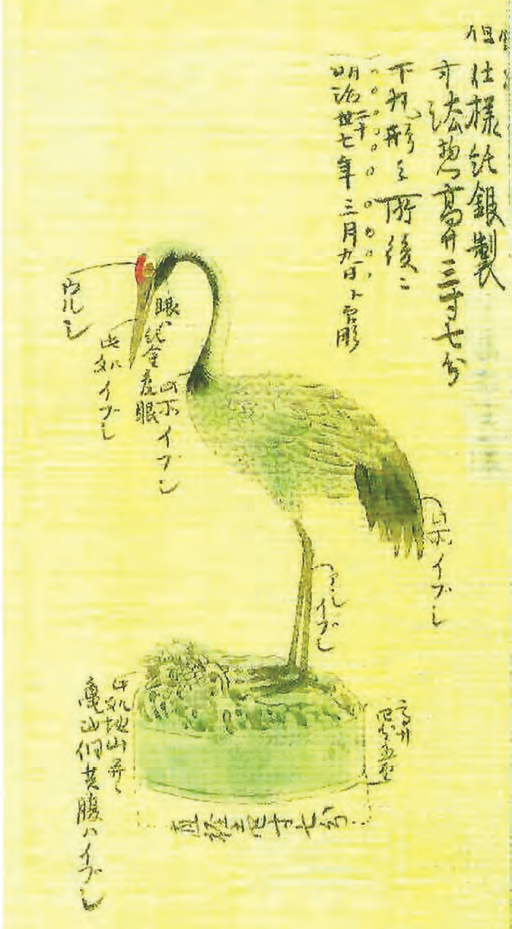
The Nancy and Robin Markbreiter Collection is a window into this rich history. The assemblage provides symbolic mementos of momentous occasions over more than a century. This prominent collection is perhaps the finest outside Japan, with its inspiration beginning almost fifty years ago. In the early 1970s, Eugene and Susan Tosk of Orientations Gallery, dealers in Meiji period (1868–1912) artworks in New York, came across an occasional example of small, heavy Japanese silver boxes at antiques fairs. Eugene, in particular, found them fascinating, as beautifully crafted miniature objects in precious metal and meticulously finished. As there was no information available at that time, the Tosks referred to them as “presentation boxes” or “presentation kogo”, which would have been used for incense. The couple had formed a sizeable collection by the 1990s, when information about bonbonnières finally came to light. The Sannomaru Shozokan (Museum of Imperial Collections in Tokyo) published their first catalogue of bonbonnières in 2000. It was a revelation and an appreciation for these historically important and beautifully crafted artworks. Several subsequent publications from various sources have revealed even more fascinating details.
The Markbreiters were inspired to collect bonbonnières after seeing a small grouping during an exhibition while attending Asia Week in New York. They have acquired a significant portion of the Orientations Gallery collection and have managed to find other rare and unusual examples. Each box serves as an enjoyable and informative device for understanding various aspects of Japanese culture, as described below.
Meiji period bonbonnières
A crane standing over, and exchanging glances with, a minogame (mythical long-tailed turtle) is illustrated (1, 2). This was the second-ever bonbonnière, presented at an imperial banquet in 1894, on the occasion of the 25th wedding anniversary of Emperor Meiji. This copy of the original Yōdoroku (Records of the Imperial Household) rendering by the artist reveals much about the object, showing its dimensions, materials and other details. For the same occasion, an oval-form box features a crane and minogame (3), though on this example engraved along with the dates of the event. This shared theme conveys a wish for longevity: for the lives, marriage and reign of the imperial couple.

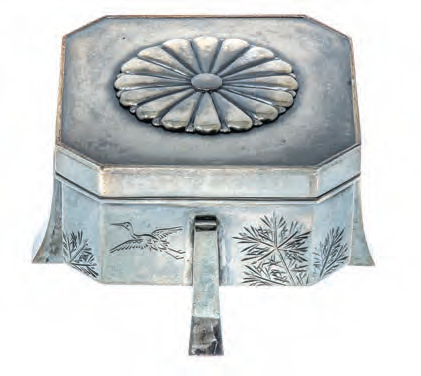
Wedding of the Crown Prince (future Emperor Taisho), 5.3 x 5.3 x 3.5 cm
The square box with canted corners (4, 5) is also accompanied by a rendering from the Imperial Household, noting details for its presentation at the wedding of the Crown Prince (the future Taisho emperor, reigned 1912–1926) in 1900. Interestingly, silversmiths who received the orders, referred to as “art dealers”, were consulted as to the various aspects of theme, form, material, etc. The ultimate advice came from Kishi Kokei (1840–1922), the celebrated aesthete, who in 1906 achieved the highest distinction of Teishitsu Gigei-in (Imperial Court Artist) in the field of design.
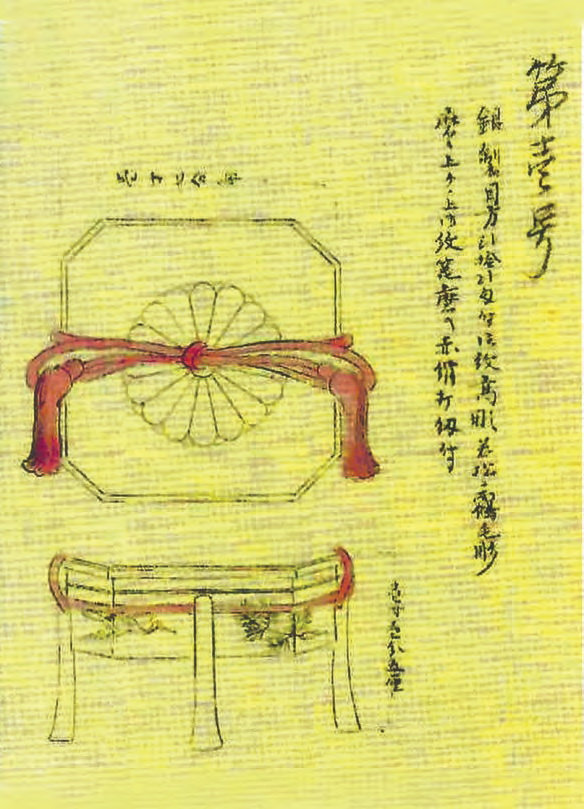
One of the rarest, and finest, bonbonnières in the Markbreiter collection is a family of three finely sculpted minogame resting atop a table with cabriole legs (6). This was an unique occasion, commissioned to celebrate the recovery of Princess Teimei from an illness in 1911; she would soon become the empress of the Taisho reign. Only a small number were made for this intimate gathering, with the symbolic longevity of the mythical turtles serving as a talisman for continued good health.
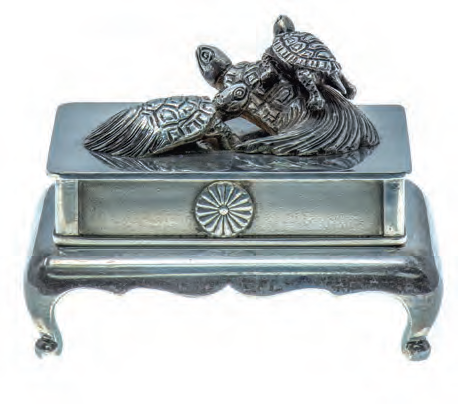
The enthronement of the Taisho emperor
In the new era following the passing of the Meiji emperor, bonbonnières took on further significance, reflecting the importance of occasions heralding the new emperor. Three noteworthy pieces were made in 1915 for the enthronement of the Taisho emperor, each with gold kikumon. The enthronement ceremony itself was represented by a bonbonnière in the form of a woven basket surmounted by the gohei, a purification wand wielded by Shinto priests during an austere ritual (7). The Shinto enthronement imagery, with overlapping oak leaves that play an important part in the imperial feast, can also be seen in an exquisite bonbonnière that has a marvellous sculptural quality (8), with substantial weight, masterful casting and finishing. The third example (9), an eight-lobed mirror form with facing phoenixes, connotes an ancient tie to nobility. This harks back to the Tang dynasty (618–907) of China, which was a formative influence for the Japanese nation.


of Emperor Taisho in Kyoto, 6.1 x 6.1 x 2.5 cm

and gold kikumon, December 8th, 1915, Tokyo banquet after the enthronement of Emperor Taisho, 6.4 x 2.5 cm
The bonbonnières from this time bore the first hallmarks identifying the quality of silver and the individual silversmith, with the first including a silver mark and seal of the maker. From then on, each bonbonnière bore either the silver hallmark or the maker’s mark (or both), shown on the base. They bear the mark, jungin (pure silver) or ginsei (made of silver), with silver content higher than that of sterling. The Imperial Household commissioned bonbonnières from more than two dozen silversmiths over the last century. Miyamoto Shoko, the silver company established in 1880, continues to receive commissions and notably produced the most recent bonbonnière in 2019 for the enthronement of Naruhito, the Reiwa emperor.
Taisho diplomacy
After the First World War, the bonbonnière became an integral part of courtly ceremony. Diplomatic ties were affirmed through these charming and memorable gifts. The coming-of-age ceremony in 1919 of the Crown Prince of the Taisho era, at age twenty, was celebrated (10). A bonbonnière also celebrates amicable Japanese-American relations at the Paris Peace Conference held at Versailles in 1919 (11), with the enamelled crossed flags representing the affinity of the two nations. The diplomatic role of the Crown Prince was affirmed in 1921, with a box honouring him for completing his royal duties and returning from travel abroad, as shown through the engraved imagery of waves (12). Later that year, a bonbonnière, in the form of an engraved world globe (13) supported on a spectacular base of sculptural winged doves, again commemorated his return.


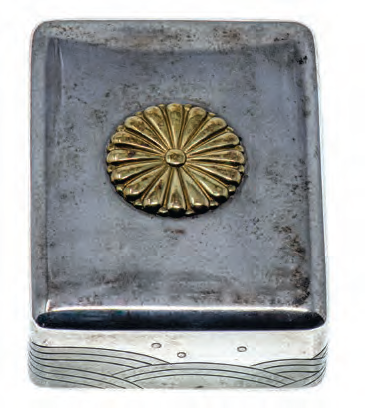

Diplomacy continued to grow in importance, as shown by another bonbonnière (14), which is a representation of an inro, with netsuke and ojime: a sophisticated gentleman’s accessory. This was presented at a dinner in 1922 at the Imperial Palace celebrating the visit to Japan by Edward, Prince of Wales. As a world-renowned dandy, perhaps this embodiment of chic accessories was executed especially for him. The importance of diplomacy is evident in another example (15), a miniature censer given at a luncheon for US Ambassador Edgar Bancroft in December 1924.
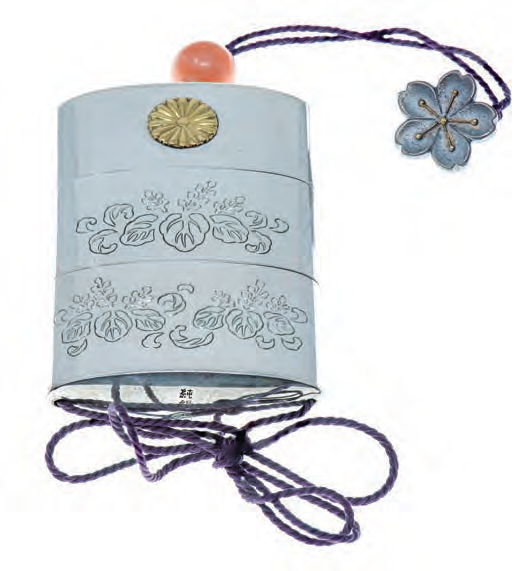

Innovation in the 1920s
The carefree artistic environment prevalent during the 1920s inspired creative efforts in producing bonbonnières: a range of intricate and elegant shapes were unveiled at important events. Among the most precious pieces in the Markbreiter collection is a beautifully sculpted rabbit resting atop a rectangular box (16), commemorating the departure of Princess Nagako of Kuni in 1924. One year later, a bonbonnière in the form of the magical mallet of Daikoku, God of Wealth, was created to mark the occasion of a luncheon for Prince George of Great Britain (17). This sculptural piece signified economic good fortune for the two countries. The naming ceremony of Princess Shigeko was celebrated in 1925 with a bonbonnière in the classical album or “book of life” form with protective cover (18). The excitement of the dawn of aviation was marked by a bonbonnière in the form of a propeller (19), with inlaid gold mon of the House of Yamashina; this was given to pilots from both Japan and Europe in 1926 for their nascent Air Forces.

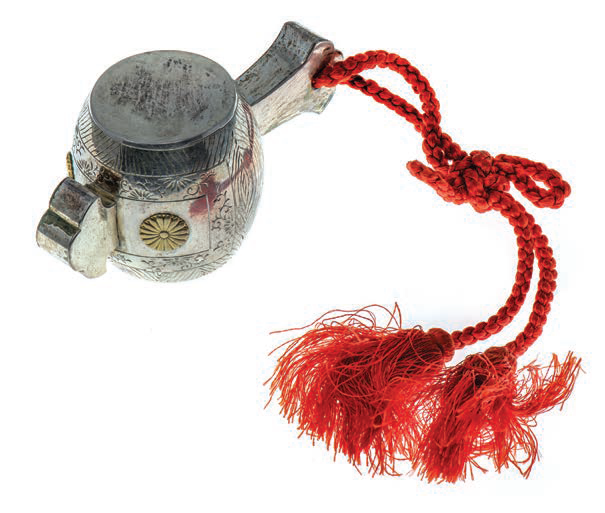
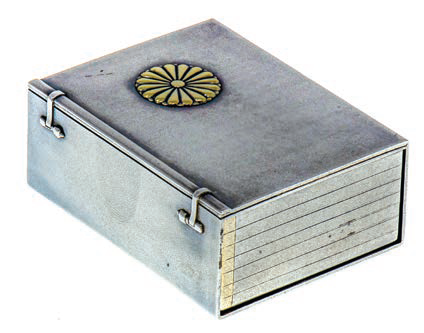

Even more elaborate bonbonnières were conceived throughout the decade. One fine example is a long-tailed rooster perched contentedly on a Taiko war drum (20), signifying hope for world peace. A fascinating composition was presented in 1924 at a luncheon for the visiting Prince of Siam (21). A rooster rests on an openwork woven basket, a hen within. All are excellent miniature sculptures. Another bonbonnière (22) shows a perfectly detailed birdcage with a pet nightingale on a perch, also presented to guests at an official luncheon marking the departure of Cyrus Woods, the US ambassador, from Japan in 1924. The presentation of bonbonnières, aimed at enhancing diplomatic ties, continued with an intricate piece in the form of a nightingale within an oval birdcage (23): this example was produced for a luncheon celebrating a visit by the Crown Prince of Sweden in 1926.




The affinity for avian imagery endured for important occasions within the Japanese homeland. Two remarkable bonbonnières were produced for the marriage of the Crown Prince (the future Showa emperor, reigned 1926–1989) in 1924. The classic pairing of crane and turtle, each symbolic of longevity, is used in subtle and clever ways (24, 25). These boxes bestow wishes for a long and happy marriage. The first, a silver crane’s egg, is elaborately engraved with a tortoiseshell pattern. This symbolism continues with the second box. The hexagonal form represents the tortoiseshell design. The distinctive rosewood box is inlaid with mother-of-pearl showing cranes in flight. The 25th wedding anniversary of the Taisho emperor in 1925 was celebrated with the spectacular sculpture of two minutely detailed cranes standing on a hexagonal base, again representing the turtle (26).


The enthronement of the Showa emperor
Fascination with bonbonnières reached a high point in 1928, with the commemoration of the enthronement of the Showa emperor. Four extravagant and technically wonderful examples were created for the event, and were presented to guests at the grand night banquet on the second day of the enthronement festivities. The miniature of a large Dadaiko drum for performance of Bugaku, an ancient courtly dance ceremony, was produced (27). This is one of the most intricate and elaborate boxes, with a golden symbol of the sun rising above the flame-shaped filigree, featuring facing phoenixes and Buddhist imagery of tama, wish-fulfilling jewels. Shinto imagery on the drum is included, with the central wind swirl of the ancient tomo-e design, conjuring the forces of nature. All of this sits on a performance stage, the side of which bears the gold-inlaid kikumon on the drawer that holds the konpeito. A party followed this banquet at Nijo Castle in Kyoto, where guests received a second bonbonnière (28). The form of the hanging lantern evokes a late-night, festive mood for the occasion.



One of the most celebrated bonbonnières was presented at an Imperial Palace luncheon the following day (29). A gold kikumon appears on the front drawer of the support for the vertical spear, signifying victory for the emperor. A silk banner is suspended from the spear, decorated with the powerful Shinto tomo-e design. The international community had increasingly taken note of the growing economic and military strength of Japan, and the significance of this event was conveyed in a lithograph published in The Illustrated London News in November 1928 (30). Note that the actual spears on their stands are more than twice human height. A fourth and final box was presented to attendees at another Imperial Palace luncheon for the enthronement (31). An elaborate helmet is worn by a dancer in the same Bugaku entertainment ritual. These four bonbonnières radiated the power and wealth of the Imperial Household to the people of Japan, and represent the zenith of technical creativity of these lavish silver boxes.



Early Showa period
The newfound respect afforded the Empire of Japan by other countries could be seen when the Duke of Gloucester visited the country in 1929. Prime Minister Tanaka hosted this representative of the British Empire, with guests receiving a beautifully enamelled box with crossed Japanese and British flags (32). Collateral branches of the imperial family commissioned bonbonnières with their own mon, well executed with deeply meaningful imagery. The box takes the form of a classic yukiwa (snowflake) design (33), bearing the mon of the House of Kitashirakawa. Made for the coming-of-age ceremony of Prince Nagahisa, imagery of a magatama overlaps with the royal chrysanthemum. The presence of the magatama harks back to ancient times, as these comma-shaped beads functioned as ceremonial objects in prehistoric Japan.
The Empress Dowager was the most powerful woman in Japan in the 20th century. As the princess, who became Empress Teimei, the wife of the Showa emperor, her relocation from one imperial residence to another was celebrated in a bonbonnière produced in 1930 (34), a handmirror case with gold kikumon and engraved violets, symbolising sincerity, love and thankfulness.



The marriage of Prince Takamatsu was celebrated in 1931 with a bonbonnière (35), depicting the gold mon of his princely branch within the design of suhama, an element of a Zen garden. The lower engraved pattern of seigaiha (endless waves) is a wish for a long and loving marital life. Princess Kikuko of the House of Asaka also married in 1931, the ceremony commemorated with a bonbonnière in the form of a ryōshibako (stationery box) bearing the mon of her royal house with engraved pine branches conveying a long bright future (36). Another ryōshibako bonbonnière, with an archer’s bow symbolising the art of kyūdō and a hand scroll as well as the gold kikumon (37), was produced in 1931 to celebrate the birth of Princess Atsuko, the daughter of the Showa emperor.


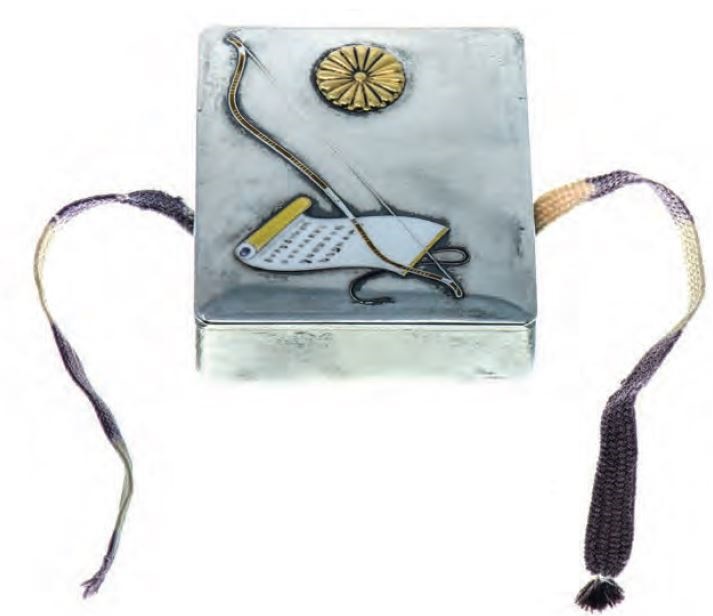

Throughout the 1930s, the type of bonbonnières produced became more insular, as global tensions grew during a period of military escalation. A silver miniature iron alloy battle helmet (38) was presented in 1932 at the coming-of-age ceremony for Prince Takahiko of the House of Asaka. The bonbonnière, created in 1934 to celebrate the marriage announcement of Prince Tsuneyoshi of the House of Takeda (39), came in the elegant form of a folding fan. The silver box features imagery of wisteria and cherry blossoms, with shakudo inlay for the clouds. The birth of Prince Masahiko, the second son of the Showa emperor, was marked in 1935 at a private banquet with a charming box in the form of a boy’s pellet drum bearing the gold kikumon (40). Prince Takahito, the youngest son of the Taisho emperor, was honoured at his coming-of-age ceremony in 1935. The ancient mokko-form of the box (41) features a gold kikumon with engraved imagery of a torii, entrance gate to a Shinto shrine, surrounded by sacred cedar trees.
In 1940, due to the country being on a wartime footing, silver was banned in Japan thanks to the “prohibition of making and selling of luxurious items”. Bonbonnières of pure silver were replaced by those formed of ceramic, lacquer or wood. A porcelain example of a nesting crane (42) was made in 1944 to celebrate the birth of Princess Yasuko of the House of Mikasa. The mon of this royal house is subtly moulded on the back of the crane.




Mid-20th century onwards
During the post-war period, bonbonnières again began to be produced in silver, but only by the direct imperial line. From this time onwards, the boxes bear the gold kikumon. The marriage of Crown Prince Akihito (the future Heisei emperor) was celebrated with one such box (43) in 1959. The gold kikumon is surrounded by oshidori, the Mandarin ducks who mate for life and symbolise a long and happy union. In 1964, the marriage of his brother, Prince Masahito, was commemorated with a round silver box (44) featuring an engraved fruiting magnolia branch. Legend has it that the magnolia tree (ogatama) serves to invite the souls of the Shinto gods for blessings. The 50th anniversary of the reign of the Showa emperor in 1976 was honoured with a bonbonnière: an elegant round silver box with a gold kikumon centred on the lid (45).






The long reign of the Showa emperor came to an end in 1989. After the enthronement of Emperor Akihito the same year, his commemorative bonbonnière (46) was presented in 1990. It shows the gold kikumon and a phoenix (ho-o) with elaborate wings and tail feathers. As part of ancient Chinese imagery, the legendary phoenix is said to appear auspiciously when a nobleman of respectable character ascends the throne. For the marriage of the Crown Prince Naruhito, the future Reiwa emperor, the lovely Mandarin duck theme is seen again on a bonbonnière produced in 1993 (47), depicting a naturalistic rendering of the oshidori gliding on a lake, beneath the gold kikumon. The latest dated bonbonnière in the Markbreiter collection hails from 1999, marking the commemoration of the tenth year of the reign of the Heisei emperor. The gold kikumon is elegantly complemented with naturalistic chrysanthemum leaves (48).
The Imperial Household continues to this day to create bonbonnières. A box was made in 2019 to commemorate the 30th anniversary of the reign of the Heisei emperor. Later that same year, a bonbonnière was created for the enthronement of the current Reiwa emperor. One crucial distinction now is that only an elite few among the Japanese nobility and foreign heads of state received these bonbonnières in pure silver. Unlike earlier bonbonnières, the vast majority of these latest two pieces were commissioned in silver-plated brass instead of the traditional, and more luxurious, pure silver. This trend makes the bonbonnière collection of the Markbreiters even more special, as these fascinating mementos of history have become more precious in every sense.
The Nancy and Robin Markbreiter Collection is distinctive in its range (of more than seventy examples), quality and rarity. The journey in creating this collection has revealed the pleasure of collecting: a delight and satisfaction in acquiring an array of meaningful and exquisite objects—elegance in the palm of your hand (49).

Acknowledgements
Thanks to Sachiko Hori, Japanese fine art consultant, for help with translation from original texts.
Much of the information provided in this article came not only from publications of the Sannomaru Shozokan (The Museum of the Imperial Collections), but from two other impeccable sources: the respective wives of the two younger brothers of the Showa emperor. In 1991, Princess Setsuko, wife of Prince Chichibu, composed a small book about her family’s collection, which greatly added to the body of knowledge. This spurred Princess Kikuko, wife of Prince Takamatsu, to evaluate her collection, adding many examples that were no longer in the holdings of the imperial collections. This culminated in another exhibition by the Sannomaru Shozokan in 2017.
Bibliography
Nagasako, Minako, Kindai Koshitsu Bunka (Culture of the Modern Imperial Household), Tokyo: Enishi Shobo, 2015.
Nagasako, Minako, “Articles by Minako Nagasako”, Tsumugu: Japan Art and Culture, published August 12th, 2019 and November 28th, 2019, https://tsumugu.yomiuri.co.jp/en/writer/minako-nagasako/.
Sannomaru Shozokan (The Museum of the Imperial Collections), The Imperial Family and Bonbonnières—Tracing Their History, Tokyo: Sannomaru Shozokan, 2017.
Sannomaru Shozokan (The Museum of the Imperial Collections), Imperial Bonbonnières, Tokyo: Sannomaru Shozokan, 2000.
Sensu, Tadashi, “Imperial Silver Bonbonnières”, in Daruma, Issue 62, Spring 2009, pp. 13–33.
Sensu, Tadashi, Imperial Silver Bonbonnières, Tokyo: Abe Publishing, 2009.

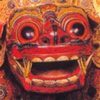 Subscribe
Subscribe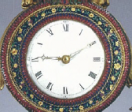 Calendar
Calendar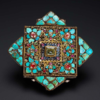 Links
Links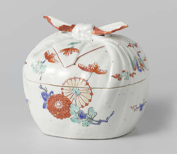 Gift
Gift

